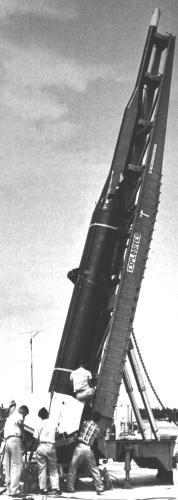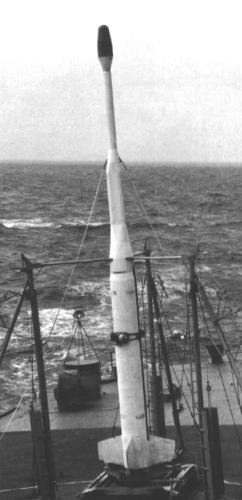Lockheed X-17
When the USAF's long-range ballistic missile development got underway in 1953/54, it was realized that there was no data available about the aerothermodynamics of the atmospheric reentry of a missile nose cone at very high speeds. To fulfill the need for a dedicated research vehicle, Lockheed received a contract for the design and construction of the X-17 missile in January 1955. The X-17 was a multistage vehicle using available and proven rocket motors and a relatively simple control system. Therefore the design phase was very short, and the first quarter-scale proof-of-concept vehicle was already launched in May 1955.
 |
| Photo: USAF via Carl Warner |
| X-17 |
The X-17 was powered by three solid-propellant rocket stages. The first stage, consisting of a single Thiokol XM20 Sergeant motor, had four stabilizing fins and two small external (strap-on) spin motors, which were jettisoned shortly after launch. After first stage shutdown, the missile coasted to an apogee of about 150 km (500000 ft), where it pitched over for a nose-down reentry. At an altitude of around 21 - 27 km (70000 - 90000 ft), the first stage was separated, immediately followed by firing of the short duration second and third stage motors. At burnout of the final stage, the X-17 had reached a speed between Mach 11 and Mach 14.5, depending on reentry angle. Equipment of the missile included a telemetry system and an AN/DPN-19 radar beacon to facilitate tracking.
 |
 | |
| Photos: USAF via Carl Warner | ||
| X-17 | ||
Three launches of quarter-scale vehicles were followed by three half-scale missiles in June and July 1955, and then by six full-scale development vehicles between August 1955 and March 1956. A problem with second/third stage performance lead to a slight delay in the program. The first actual X-17 research missile was finally launched in April 1956, followed by 25 additional flights until March 1957. The program achieved all its objectives, and several different nose cone shapes were tested under high-speed reentry conditions.
In 1958, seven more X-17 missiles were built for Project "Argus", which tested the effects of nuclear explosions outside the atmosphere. For this purpose, all three stages of the X-17 were fired during the climb phase, allowing the missile to reach altitudes of up to 480 km (300 miles). Four unarmed "Argus" launches were followed by three nuclear shots (with yields of 1-2 kT) during August and September 1958.
Specifications
Note: Data given by several sources show slight variations. Figures given below may therefore be inaccurate!
Data for X-17:
| Length | 12.33 m (40 ft 5.5 in) |
| Finspan | 2.31 m (7 ft 7 in) |
| Diameter | 1st stage: 79 cm (31 in) 2nd stage: 43 cm (17 in) 3rd stage: 24.7 cm (9.72 in) |
| Weight | 5400 kg (12000 lb) |
| Speed | Mach 14.5 |
| Ceiling | 150 km (500000 ft); 480 km (300 miles) in three-stage ascent |
| Propulsion | 1st stage: Thiokol XM20 Sergeant solid-fueled rocket; 213 kN (48000 lb) for 28 s 2nd stage: 3x Thiokol XM19 Recruit solid-fueled rocket; 150 kN (33900 lb) each for 1.53 s 3rd stage: Thiokol XM19E1 Recruit solid-fueled rocket; 160 kN (35950 lb) for 1.53 s |
Main Sources
[1] Jay Miller: "The X-Planes X-1 to X-45", Midland Publishing, 2001
[2] Peter Alway: "Rockets of the World", Saturn Press, 1999
Back to Directory of U.S. Military Rockets and Missiles, Appendix 1
Last Updated: 13 February 2003